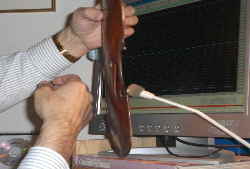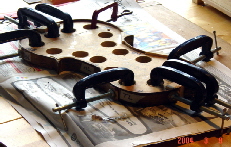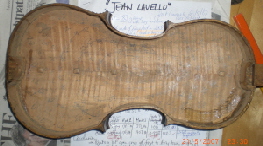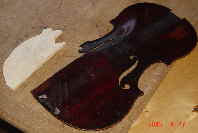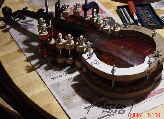|
German “Bench fiddle”, circa 1800, unlabelled copy of D Hopf.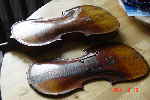
A couple of years ago I asked a friend of mine for his ‘worst fiddle': I wanted to see how good I could make it sound by matching the stiffnesses of the front and back plates. And it's turned out rather well, though it does look rather like Humpty Dumpty after his fall!
This is a ‘cottage' or bench ‘transitional' fiddle probably made in Germany in the early 1800's, as the neck was too short by 10mm, but with the more modern neck angle. No machines whatsoever were involved in its making: it is strictly hand-made, and made in a hurry! The arching is somewhat crude. The arching is somewhat crude.
As you can see right in the picture of the fiddle as received, the front had no bassbar and worse, it had a crack along where the bassbar should be. There were no upper linings at all, no purfling (it's inked in), and the neck extended into the body to form the upper block, in the German tradition.
I thought I might end up using this as firewood, but with the bassbar crack glued up the front had a good tap tone,  so I used it as an experiment, taking the stiffness factors of front and back plates quite low, set the thicknesses right and added a bassbar to the belly(see right). so I used it as an experiment, taking the stiffness factors of front and back plates quite low, set the thicknesses right and added a bassbar to the belly(see right).
Then I took the back right out too: it got damaged, but it meant I could set the tap tones and back's stiffness exactly where I wanted, and confirm the relationships of the tap tones of the back plate (both Modes 2 and 5) in and out of the bouts. Repaired and glued back onto the bouts, onto the sides and onto 6 new blocks it's quite constructionally challenged.
 The bouts were 4 mm thick in places, so I reduced them with a Dremel-type grinder to about 1.2 mm. You can see the back's thickness contours on the back plate here. The bouts were 4 mm thick in places, so I reduced them with a Dremel-type grinder to about 1.2 mm. You can see the back's thickness contours on the back plate here.
The neck had to be lengthened too with new maple, and set it into the new neck block. Not pretty, but effective. I haven't got the skills (yet?) to do a pegbox graft, and it wouldn't be worth the time on this fiddle. Not pretty, but effective. I haven't got the skills (yet?) to do a pegbox graft, and it wouldn't be worth the time on this fiddle.
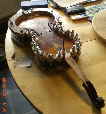 You can see the lengthened neck here on the right. You can see the lengthened neck here on the right.
What does it sound like? Great! for Irish or English dance music, with a strong A and stronger E string, with a good ‘bite' to the sound using hard bowing. The G string is quite good, but the fiddle back is too light to have real G-string grunt, confirming what Dr. Harris says about the ratio of front and back plate weights. The D string is quite acceptable, but like all my fiddles so far, the D string lets the rest of the fiddles tone down: a little weak, and slightly ‘scratchy' as each bowed note begins.
Recently I put a proper Thomastik Dominant G string on it, and which is much more respectable now - it shows good strings can improve tone.
This fiddle is good enough to use on a recording, so it was used in a set of songs for a charity concert we put onto CD just before Christmas ‘07. This a part of Jane Gridley's ‘Horace goes to London' with this fiddle doing both the rhythm bowing in the background and the ‘descant' over the voice.
Here is the response of this fiddle using the bowed ‘semitone loudness' method described on this page. It shows the 3 main frequency responses are roughly right, but it's a little weak on ‘G's on both the D and E strings.
|
